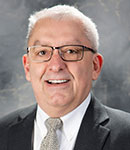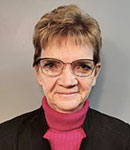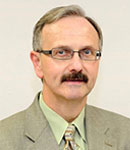In Their Own Words
By Jena Pierce on
Four long-term rural and public health administrators are retiring in 2022, leaving legacies while taking decades of knowledge and institutional history with them. We asked them to think about the state of rural health, how it has evolved and changed over the years, what they hope to see in the future, and advice for those stepping into their shoes. Here are their thoughts, in their own words.
The administrators include:
 Pete Antonson Soon to be retired CEO Northwood Deaconess Health Center |
 Darrold Bertsch Retired CEO Sakakawea Medical Center |
 Julie Ferry, MS, RN Retired administrator Nelson-Griggs District Health Unit |
 Dan Kelly Retired CEO McKenzie County Healthcare Systems, Inc. |
How long have you been in healthcare?
Pete Antonson: 39 years.
Darrold Bertsch: I have worked in healthcare for 48 years, up until my retirement as a full-time CEO last year, with the last 28 years serving as a CEO.
Julie Ferry: 45 years – I received my Bachelor of Science in Nursing in 1977 and knew I wanted to go into public health. I have been a registered nurse in hospitals, worked in long-term care, and finally public health in 1983. I completed my master's degree from the University of North Dakota in 2011 while working in public health full time.
Dan Kelly: I have worked in healthcare more than 40 years. For 32 years, I have been in the CEO role.
How has healthcare changed during your career?
Pete Antonson: One could probably come up with a list the length of my arm. I will focus on four areas: regulatory, technology, payment, and staffing.
The regulations have grown exponentially over the years. Now, the policies and the paperwork matter at least as much than the care you provide. Most of these are driven federally, often in response to a crisis or some bad outcome(s). It seems as if a new set of rules and regulations are added rather than enforce those that are already in place. There is never a subtraction, but always an additional burden on staff.
When I started, there was one computer in the building used to process insurance claims. Today, there are computers everywhere. Budgets for information technology have exploded.
Payment methodologies continue to evolve. When I started in the business, you set your rates, and the insurance companies paid you. Now all payments for commercial insurance are set by contract. One has to spend time carefully reviewing contracts to ensure that proper and adequate payment are provided in the agreement. In the past, services were provided at the discretion of the ordering physician, billed, and paid. Now preauthorization is required for many services.
Finally, employment and staffing has changed. Each generation of people has unique and different characteristics, and their priorities, styles, and work ethics are far different between generations.
When I started working, we had a file full of job applications. When a position opened, we simply called someone in to interview. People were anxious to work, and often stayed in one place for decades. Today, we recruit aggressively. We use sign-on bonuses, employment agencies, and fill positions by recruiting almost worldwide.
Darrold Bertsch: When I started in healthcare, Prospective Payment Systems and Diagnosis Related Groups were just in the development stage. Needless to say that brought on change, as will the current shift from volume-based provider reimbursement for value-based reimbursement.
The other thing that has changed significantly is the evolution of technology...it's been an amazing shift.
The other thing that has changed significantly is the evolution of technology. From paper medical records, punch cards for data entry, personal computers, dot matrix printers, and the internet, to where we are today with technology, it's been an amazing shift.
Additionally, the significant improvements in diagnosis and treatment of disease has been amazing. And, of course, we are in a shift from just treatment of disease to helping our patients and communities with wellness, prevention, and enhanced care coordination.
Julie Ferry: As I reflected on the many changes in public health, one of the most significant is the number of vaccines developed for vaccine-preventable diseases in children. From only needing Polio, Diphtheria-Tetanus combination, to the combination Measles-Mumps-Rubella (MMR) vaccine, to today's recommendations of Polio, Diphtheria, Tetanus, and Acellular Pertussis, Haemophilus Influenzae B, Rotavirus, Chickenpox vaccine, Hepatitis A, Hepatitis B, Pneumococcal conjugate vaccine, two types of Meningococcal vaccine and Human Papillomavirus vaccine. Parents trusted their healthcare provider and the science versus today's social media sites of the anti-vaccination groups.
Another significant change is how we approach public health behaviors. We learned enacting policies with appropriate enforcement and providing a supportive community environment work better than simply trying to change an individual's behavior.
How information is disseminated has increased. This includes using paper/pencil posters, printed newspaper ads and articles, using radio and TV media, and being internet savvy with social media sites.
Lastly, mental health services are needed in every aspect, from substance abuse prevention to school health to home visits. There is no easy fix, so working with legislators who allocate resources and create state policy via laws is essential.
Dan Kelly: In the 1980s, administrators did not have to worry about length of stay or for the financial viability of their facility. At that time, there was less concern about paperwork and bureaucratic regulation. The focus was on the patient. In general, life was simpler then for the hospital administrator.
From a positive perspective, I can think of two items. First, hospitals have equipment and pharmaceuticals that allow patients to live; wherein previously the outcome would have been death. Second, even rural hospitals have technology and capabilities that are similar to those of more urban facilities. I have been impressed with the speed at which the industry continues to innovate.
Where do you see rural health going over the next 20 years?
Virtual care will likely become not only an option, but potentially a highly used method of service delivery.
Pete Antonson: Rural health will still be here and be needed. Nursing home care will not be as widely available in rural areas. Small towns are seeing that their nursing homes are impossible to staff, and thus closing. Hospital care will continue to evolve with less and less inpatient care and a continued growing use of outpatient care. Virtual care will likely become not only an option, but potentially a highly used method of service delivery. Remote monitoring will likely become common. More and more healthcare will be delivered on the road, rather than in the brick and mortar. Networks and affiliations will be integral for small facilities.
Darrold Bertsch: I certainly believe that advancements in technology and healthcare delivery will continue. The need for hospitals, clinics, and skilled nursing facilities will likely continue, but telehealth services, remote patient monitoring, and care at home will likely become more commonplace. And who knows exactly where artificial intelligence (AI) take healthcare delivery in the future.
Julie Ferry: Both rural and public health leaders will need to collaborate even more as there's only so many professional staff to go around. It's even harder in the rural areas to recruit physicians, dentists, optometrists, nurses, just to name a few.
Telehealth will be a bigger tool to use to diagnose and treat. The acute care side of the spectrum of healthcare needs advanced technology and when you live and work in rural communities, it's hard to travel to see that specialist if the local healthcare provider refers you. I worry that there will be less generalist healthcare providers with new graduates seeking specialty areas.
Virtual conferences and meetings will increase. Will there be fewer collaborative statewide relationships developing because of virtual communication? Discussion through written email can be misconstrued. It takes those one-on-one meetings to work best, in my opinion.
Dan Kelly: Most any rural administrator will tell you that rural hospitals struggle financially. I am particularly concerned at present about the inability to secure employees. Historically, it was difficult to find pharmacists, nurses, and other degreed professionals. Today, facilities are unable to hire into skilled positions but also now have a difficult time hiring maintenance, housekeeping, and billing staff. I believe that facilities will need to rely more on telehealth and technology such as AI.
What advice would you give someone just starting out in your position?
Pete Antonson: Get involved with associations such as the North Dakota Hospital Association, the North Dakota Rural Health Association, and the Center for Rural Health. It helps develop a network of not only friends, but peers you can work with to problem solve and learn.
Shadow different organizations. Big isn't for everybody. Small isn't for everybody. Find a place where your work culture, your values, and your interests can flourish. Hire smarter people than yourself, pay them a good salary, and get out of their way. Understand finance or be sure you have a good finance person on your team.
Darrold Bertsch: A career in healthcare is a very fulfilling and rewarding career. We make such a huge difference in the lives of our communities and the patients that we are privileged to serve. Never take that for granted.
If you are just starting your career in healthcare administration, having a solid educational foundation is certainly important. Just as important is to learn from your day-to-day experiences as you navigate healthcare leadership. We can learn so much from those experiences, those that we work with day in and day out, and our peers have a great deal of knowledge that they can share with us.
Never stop learning about what you're doing and those around you. Here are a couple of things that I have felt are important. As leaders and organizations, we are only as good as the teams we have in place. As CEOs, I've always likened my job to that of the director of an orchestra: we have a lot of great talent and expertise in place, we just have to get them all on the same sheet of music (mission, vision, and values) and produce a great outcome.
Julie Ferry: My advice for anyone in public health is build those local, regional, and statewide professional relationships. It starts with communication – both listening and advocating to best serve your local community, but also to speak out for public health across the state. Most don't understand all that Local Public Health Units are doing in their own agencies. We are not cookie cutter offices so when you've seen one Public Health Unit, you've seen one Public Health Unit. The expertise of staff and community needs differ just as large healthcare facilities differ from small facilities.
Public health issues aren't just immunizations or setting up medications with home visits. Prevention work is hard, especially when talking about substance abuse issues in our alcohol-tolerant society. Public health staff need to analyze community data to educate our community members and local and state policymakers about the needs, but also weave in lived experience to make the data real.
If you are fortunate to have a good board, build on that relationship and always be overtly honest with them.
Dan Kelly: For young administrators, you need to afford time for yourself and your family. Your job is important but that importance pales in comparison to the responsibility you have to care for yourself and your family. I suggest that young administrators find a mentor, or a group of trusted advisors, and reach out to them. Always be willing to listen to others. If you are fortunate to have a good board, build on that relationship and always be overtly honest with them. Trust goes a long way toward facilitating support from the board during difficult times. Be innovative. For those close to you, focus on hiring those that supplement your weaknesses. Hire the best persons you can and give them the freedom to do their job. Do not ignore items that need your address.
What is your favorite thing about living/working in rural North Dakota?
Pete Antonson: Work with people you know. Provide care to people you know. You have an opportunity to make a difference. It is a great place to raise a family. Note I didn't say anything about the weather.
Darrold Bertsch: I really love the quality of life that we have living in rural North Dakota. We know our communities, we know our neighbors, and we are always there to support each other. Our work in rural healthcare is so important, but because we choose to call rural home, we shouldn't have to sacrifice the quality of healthcare services we receive. When we care for our patients, they are often our relatives, friends, and neighbors. That makes it even more special.
The great thing is everyone knows you – the bad thing is everyone knows you!
Julie Ferry: Everything always comes back to the people of North Dakota. The great thing is everyone knows you – the bad thing is everyone knows you! When everyone knows you, they know your parents, grandparents, spouse, and kids. You know which kids faint or are nervous about their upcoming immunizations, but the parents know you'll get the vaccines done in a caring and confidential setting. The good far outweighs any challenges like bad weather. We have scenic views everywhere!
Dan Kelly: When I was hired, I knew that this facility had undergone a period of frequent turnover within the administrator position. Given that, I told them I absolutely would give them three years and perhaps five. I have been at this facility approximately 15 years. I sincerely appreciate the collaborative nature of North Dakota healthcare administrators.
I appreciate the fact that we are a relatively small state thus it is possible to actually meet, in person, with your state and federal legislators. In general, people in North Dakota have common sense which I found lacking in some areas where I previously lived. I love the rustic beauty of this state. While you did not ask, my dislike of the wind and harsh winters has not diminished.
Thank you to Pete, Darrold, Julie, and Dan for sharing your thoughts, expertise, and hopes for rural health and public health. And thank you all for dedicating your careers to supporting and caring for the people of North Dakota. We owe you all a debt of gratitude.


 is the communications manager at the Center for Rural
Health at the University of North Dakota School of
Medicine & Health Sciences in Grand Forks.
is the communications manager at the Center for Rural
Health at the University of North Dakota School of
Medicine & Health Sciences in Grand Forks.



